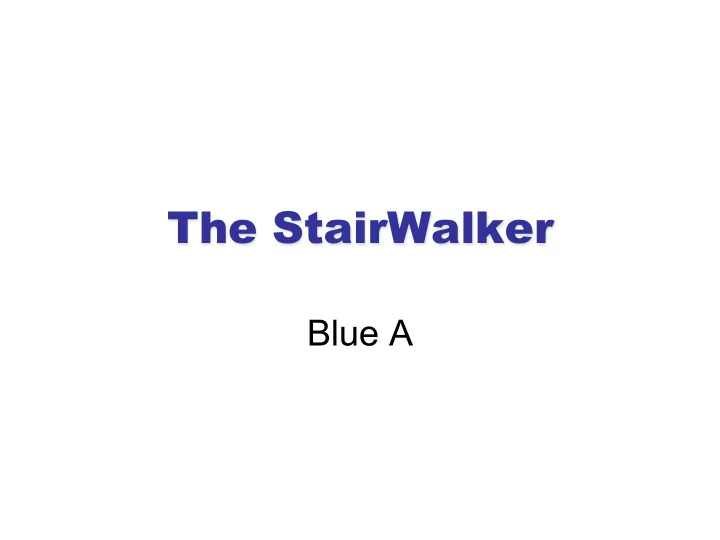

The StairWalker Blue A
Walking Aids with Stairs UCSF Disabilities Statistics Center study on mobility device use: • 1.8 million Americans use walkers • Only 39.3% of mobility device users live in houses with just one floor • 62.1% of mobility device users must climb steps to get in or out of their homes • Only 9.6% of mobility device users have added stair-climbing features Our contact, Luis Loya (Access Planner for Kessler McGuinness and Associates) verifies need for product.
Current Products Stair lifts: Expensive: • Person sits on chair, • Cheapest are about which then climbs up the $2,500 side of the wall No walker: • Will not bring up the walker, so person lands on the upper floor without walking aid
Current Products Safety risk → falling US Patent 6,453,921B1: • 1/3 of people 65 and • Retractable legs older fall at least once a • Activated by gripping year handle • Fear of falling is main fear among elderly, above robbery and financial fears Requires hand dexterity , which elderly often don ’ t have
The StairWalker • Attaches to the railings • As the user pushes the walker up against the bar, the StairWalker moves up too • The StairWalker will not fall back down
How It Works • Walker attaches to a crossbar at the front • Rubber rollers to firmly grip the railing • Uses ratchets to keep from falling down
Features Critical parts: • Safety – prevents user from falling • Properly compressible rubber rollers to grip • Mobility – helps rail users have full access to their walkers • Sliding enough to push it up • Low cost • Interfacing with the • Requires minimal wall and existing installation railing
Further Considerations Going down stairs: Range of railing shapes and sizes: • Orient the rollers on each side in different • Attach a baseline directions. Lock one track to the railing, side each time, sold with the depending on StairWalker. direction. • The box could clamp For railings that do not onto the railing from start at the first step, the top, or from the include rail side → extension.
Further Considerations Going down stairs: Range of railing shapes and sizes: • Orient the rollers on each side in different • Attach a baseline directions. Lock one track to the railing, side each time, sold with the depending on StairWalker. direction. • The box could clamp For railings that do not onto the railing from start at the first step, the top, or from the include rail side → extension.
StairWalker Can be an aid and asset to the 1.8 million Americans who use walkers.
References • Kaye, H. Stephen, Taewoon Kang, Mitchell P. LaPlante. “ Mobility Device Use in the United States. ” UCSF Disabilities Statistics Center , June 2000 http://dsc.ucsf.edu/publication.php? pub_id=2§ion_id=1 (1 October 2008). • “ Use walkers to lower the risk of falling ” India eNews , 5 February 2008 http://www.indiaenews.com/europe/20080205/95666.htm (1 October 2008). • Howland, Jonathan, et al. “ Fear of Falling among the Community-Dwelling Elderly ” , Journal of Aging and Health , 5, No. 2 (1993): 229-243. • Rost, Brian M. “ Stair walker. ” US Patent 6,453,921 B1. 24 September 2002.
Recommend
More recommend